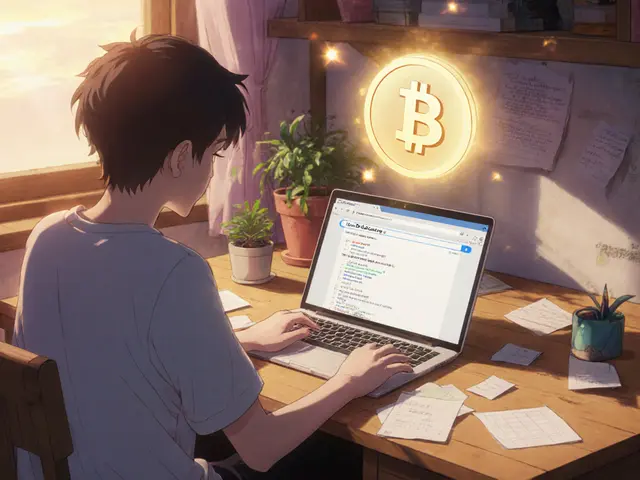Morpheus (MOR) Earnings Calculator
Compute Provider Earnings Calculator
Calculate your potential monthly earnings from running a Morpheus node. Based on NVIDIA GPU specifications and electricity costs.
Morpheus (MOR) isn't just another cryptocurrency. It’s an attempt to build a decentralized network where AI agents can work for you-like a personal assistant that runs on blockchain, earns rewards, and executes smart contracts without human input. Launched on May 8, 2024, MOR is designed to pay people for contributing computing power, capital, or code to an AI infrastructure that doesn’t rely on big tech companies. If you’ve ever wondered what happens when AI meets crypto, Morpheus is one of the first real-world experiments trying to answer that.
How Morpheus Works: Four Ways to Earn MOR Tokens
The Morpheus network doesn’t just hand out tokens. It rewards four distinct roles that keep the system running:
- Builders create apps, AI agents, or tools on the network. They earn MOR based on how many people use their creations.
- Capital Providers lock up stETH (staked Ethereum) to help fund the network. In return, they get a 3.8% annual yield on their ETH plus extra MOR tokens.
- Code Contributors fix bugs, write new features, or improve the open-source code. Their rewards are tied to how much their code gets used.
- Compute Providers run AI models on their computers. You need an NVIDIA GPU with at least 8GB VRAM, 32GB RAM, and a fast internet connection. For every AI query your machine processes, you earn MOR.
Every day, 14,200 MOR tokens are distributed across these four groups. But here’s the catch: the exact split between them isn’t public. That lack of transparency has raised eyebrows among investors who want to know exactly how much they can earn.
Technical Setup: Can You Run a Node?
If you’re thinking about becoming a compute provider, be ready for a technical challenge. The official documentation rates the setup as “Advanced.” You need to know Python, Solidity, and Docker. Most users report it takes about 7 hours to get a node up and running. Even then, 63% of new operators run into GPU driver issues.
The Morpheus Discord community has a troubleshooting guide (version 2.1.4) that helps with common problems like CUDA errors or memory leaks. But support is slow-only 28% of reported issues get resolved, and responses often take over 4 hours. If you’re not comfortable with command-line tools or debugging blockchain software, this isn’t the project for you.
Where to Buy MOR and Liquidity Risks
As of November 1, 2025, you can only trade MOR on one exchange: CoinEx. That’s it. No Binance. No Coinbase. No Kraken. This makes liquidity extremely tight. The 24-hour trading volume hovers around $27,000, which is less than what major crypto coins make in a single minute.
Users on Reddit have reported being unable to withdraw funds from CoinEx due to API failures. One person lost $287 in transaction fees trying to move their tokens. That kind of risk isn’t something most retail investors are prepared for. Even if you believe in Morpheus long-term, getting in and out of the position is a gamble.

How Morpheus Compares to Other AI Crypto Projects
Morpheus isn’t the only AI-focused crypto project. Here’s how it stacks up:
| Project | Focus | Market Cap (Oct 2023) | Exchanges | Key Advantage |
|---|---|---|---|---|
| Morpheus (MOR) | Personal AI agents | $27M | 1 (CoinEx) | StETH yield + MOR rewards |
| Fetch.ai | Enterprise AI agents | $1.42B | 27 | High liquidity, proven adoption |
| SingularityNET | AI marketplace | $423M | 19 | Wide range of AI services |
| Ocean Protocol | Data marketplace | $423M | 21 | Strong data ownership model |
Morpheus targets a niche: personal AI assistants that act on your behalf. Fetch.ai and SingularityNET go after businesses. That’s not necessarily bad-it means less competition. But it also means fewer users. Only 2,140 people are actively using the Morpheus network. Most of them are developers or miners, not regular people.
Is Morpheus a Good Investment?
Let’s be honest: MOR is a high-risk bet. The token price is around $2.76, but its value is tied entirely to network usage. If no one runs nodes, no one earns MOR, and the price drops. Right now, 87% of compute power comes from just 12 nodes-most of them controlled by the founding team. That’s a red flag. A decentralized network shouldn’t rely on a handful of insiders.
There’s also a legal risk. The SEC is watching. Because MOR is distributed as a reward for participation, legal experts at Perkins Coie LLP say it could be classified as a security. If that happens, the project could be forced to halt token issuance or face penalties.
On the upside, the team is working on “Project Prometheus,” a privacy upgrade using zero-knowledge proofs. If it launches in Q1 2024 as planned, it could make Morpheus more attractive to privacy-focused users. But that’s a big “if.”

Who Should Avoid Morpheus?
You should stay away from Morpheus if:
- You want to trade MOR easily-there’s no liquidity.
- You’re not tech-savvy-setting up a node is not beginner-friendly.
- You’re looking for short-term gains-the token is too volatile and illiquid.
- You’re risk-averse-the project has regulatory, technical, and centralization risks.
Even experienced crypto users are divided. One Reddit user earned $390 a month running an RTX 4090 node. Another lost nearly $300 because they couldn’t withdraw from CoinEx. It’s a wild ride.
Final Verdict: Niche Potential, High Risk
Morpheus (MOR) is a bold idea. It’s trying to solve a real problem: how to build a decentralized AI economy where everyday people can contribute and get paid. But it’s still in its infancy. The technology works in theory, but the real-world execution is shaky. Low liquidity, centralized compute power, and unclear tokenomics make it dangerous for most investors.
If you’re a developer with spare GPU power, a deep interest in AI, and the patience to deal with slow support, Morpheus might be worth experimenting with. But if you’re looking for a stable crypto asset or a simple way to earn passive income, look elsewhere.
The AI crypto space is growing fast-projected to hit $50 billion by 2028. Morpheus holds just 0.0003% of that market. It has a chance to grow, but it needs massive improvements in liquidity, decentralization, and user support. Right now, it’s more of a technical experiment than a reliable investment.
Can I buy Morpheus (MOR) on Coinbase or Binance?
No, you cannot buy MOR on Coinbase, Binance, Kraken, or any other major exchange. As of 2025, CoinEx is the only exchange where MOR is traded. This severely limits liquidity and makes buying or selling difficult and risky.
Do I need a GPU to earn MOR tokens?
Yes-if you want to earn MOR as a compute provider. You need an NVIDIA GPU with at least 8GB VRAM, 32GB of RAM, and a stable 1Gbps internet connection. Without this hardware, you can’t run AI inference tasks and won’t earn rewards from processing user queries.
Is Morpheus safe to invest in?
Morpheus carries high risk. The network is centralized (87% of compute power comes from 12 nodes), liquidity is extremely low, and the SEC may classify MOR as a security. While the concept is innovative, the current implementation is unstable. Only experienced, high-risk investors should consider it.
How much can I earn running a Morpheus node?
Earnings vary. One user reported earning 142 MOR per month ($390 at $2.76 price) using an RTX 4090. But after gas fees and electricity costs, net returns can drop below 10%. Earnings depend on demand for AI processing, your hardware efficiency, and network-wide participation.
What’s the difference between Morpheus and Fetch.ai?
Morpheus focuses on personal AI agents that act on behalf of individual users, while Fetch.ai targets enterprise AI agents for businesses. Fetch.ai has a much larger market cap, higher liquidity, and broader adoption. Morpheus is smaller, riskier, and more experimental, but it’s one of the few projects trying to decentralize personal AI.
Is Morpheus open source?
Yes, Morpheus is fully open source. The code is hosted on GitHub, and developers can contribute to the protocol. However, the documentation is technical and lacks beginner guides, making it hard for newcomers to get involved.
What’s the future of Morpheus?
The team plans to launch Project Prometheus in Q1 2024, adding zero-knowledge proofs for AI privacy. They aim for a $50M market cap by Q3 2024. But independent analysts consider these goals unrealistic given current growth rates. Long-term success depends on attracting more users, improving liquidity, and decentralizing compute resources.







Write a comment
Your email address will be restricted to us